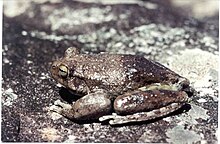Bokermannohyla alvarengai
| Bokermannohyla alvarengai | |
|---|---|

| |
| Scientific classification | |
| Domain: | Eukaryota |
| Kingdom: | Animalia |
| Phylum: | Chordata |
| Class: | Amphibia |
| Order: | Anura |
| Family: | Hylidae |
| Genus: | Bokermannohyla |
| Species: | B. alvarengai
|
| Binomial name | |
| Bokermannohyla alvarengai (Bokermann, 1956)
| |
| Synonyms[3] | |
| |
The Santa Barbara tree frog or Alvarenga's tree frog (Bokermannohyla alvarengai) is a frog that lives in Brazil. It lives in the Serra do Espinhaço mountains.[1][2][3]
With most frogs, the adult female is larger than the adult male. But with these frogs, the male frog is larger than the female frog. The male frogs also have larger, stronger front legs and larger spines. Scientists say that when male frogs are larger than female frogs, it is because the male frogs fight each other. Male Santa Barbara tree frogs sometimes have scars on their skin that could be from fighting each other. But few teams of scientists have watched and written science papers about Santa Barbara tree frogs. They do not know for sure if this is why the male frogs are larger.[4]
References[change | change source]
- ↑ 1.0 1.1 "Bokermannohyla alvarengai". Amphibiaweb. Retrieved February 9, 2022.
- ↑ 2.0 2.1 Jaime Bertoluci; Débora Silvano (2010). "Santa Barbara Treefrog: Bokermannohyla alvarengai". 3.1. The IUCN Red List of Threatened Species: e.T55385A11289092. doi:10.2305/IUCN.UK.2010-2.RLTS.T55385A11289092.en. 55385. Retrieved February 9, 2022.
{{cite journal}}: Cite journal requires|journal=(help) - ↑ 3.0 3.1 "Bokermannohyla alvarengai (Bokermann, 1956)". Amphibian Species of the World 6.0, an Online Reference. American Museum of Natural History. Retrieved February 9, 2022.
- ↑ Fernanda C. Centeno; Aurélien Vivancos; Denis V. Andrade (2021). "Reproductive Biology and Sexual Dimorphism in Bokermannohyla alvarengai (Anura: Hylidae)". Herpetologica. 77 (1): 14–23. doi:10.1655/HERPETOLOGICA-D-19-00070. S2CID 232326827. Retrieved February 9, 2022.

